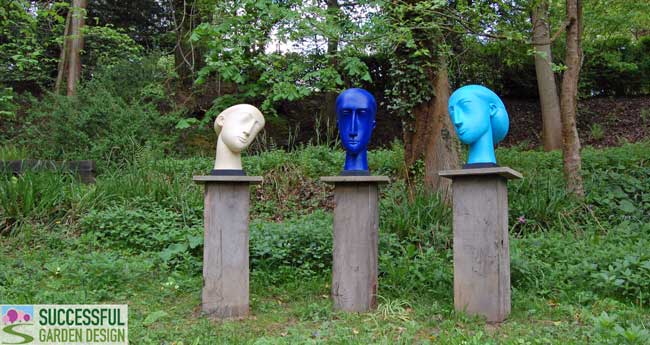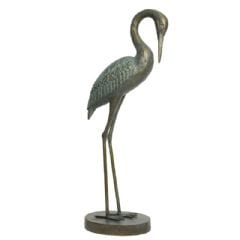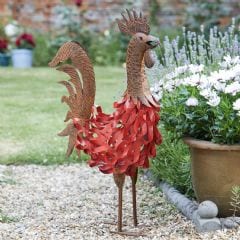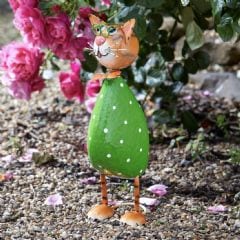
So although I’ve never met you, the chances are high I can guess where you’d stick a focal point or garden feature…
Where there’s a big hole… in your planting! ;o)
Would I be right?
I may not of course, but it’s what most people do.
Makes sense – can’t get plants to grow well, might as well put a statue, birdbath, or attractive feature of some description there.
As much sense as that makes, it’s a really bad idea unless your…
Focal point lines up with key viewpoints
So what do I mean by that?
Well, the sightline down your garden from the house ie the main window or doors you look out from the most.
Or at the end of a path or patio.
Wherever your eye would naturally come to rest is a great place for a focal point as shown with FP in the image below.

Now, if you’ve created a design layout for your whole garden (something I highly recommend if you want success without wasting a ton of cash), then you can get a bit more adventurous with your focal point placement.
Use focal points to draw the eye to where you want it to go
You might think that goes against what I said earlier, but it doesn’t when you strategically place them in a good design layout.
With a good design, the shapes you use within it do one thing – control how the garden flows. This is a fundamentally important part of landscape design that’s rarely talked about.
With the right shapes, you can make wide, shallow gardens look longer. And vice versa, long, narrow gardens can be made to look wider. Small gardens, larger, and awkward gardens can completely lose their awkwardness.

Doing it this way is a world apart from plonking an expensive work of art wherever there happens to be a gap in the planting!
Strategic placement enables you to get the most from your garden and your focal points!
What makes a good focal point/garden feature?
Anything with a good solid outline.

It can be something simple as a pot, bench, topiary, statues, gazebos, upright timbers or more adventurous sculptures.

Unusual things can also be used like ornate gates, windows (see image on left), mirrors (the focal point is what it reflects back, not the mirror itself).
Literally, anything solid as that gives the eyes something definitive to rest on.
You can put a focal point in a border but equally, they can look good just on their own if they are in the right position.
The three heads below are positioned at the end of the garden before a woodland area, and the group make a big impact. I like how it looks like three friends are contemplating life and the slight angle each one is turned makes it feel intimate, rather than a row of soldiers lined up!

How many focal points or features should you have?
This is one of the hardest to advise on. It all depends.
I know, horrible answer, but it really does!
Here are a few guidelines though:
- At the end of paths
- At the end of the sightline from the main window or doors
- Every time a design shape changes direction (see image above)
Weird rule – small gardens can often take a lot more focal points than larger gardens.
I’m not entirely sure why smaller spaces can get away with more focal points, but they just seem to. If you try to put a lot of focal points in a large garden, it immediately looks cluttered (if you can see them all at once).
As you can see in this tiny garden, there are 5 focal points (6 if you’ve counted the topiary in the pot twice as it’s reflected back in the mirror!).

This was a display garden at a garden centre so there was a lot of product placement in an area that was 4 x 5m. But even though there’s more here than you would probably do at home, it does go to show how small spaces can take a lot more than you’d imagine…
Garden Statue Focal Points
-

Smart Garden Gazing Frog Solar Figurine
£19.99 Buy Now -

Smart Garden Hare Magic Solar Figurine
£19.99 Buy Now -

Gardman Ladybird Garden Ornament – Large
£9.99 Buy Now -

Ellister Pelican Standing Ornament
£59.99 Buy Now -

Ellister LED Solar Ladybird Ornament
£12.99 Buy Now -

Smart Garden Bertie Rooster Garden Ornament
£17.99 Buy Now -

Smart Garden Polka Pets Spangle Cat Garden Ornament
£9.99 Buy Now -

La Hacienda Cool Chameleon Tanzania Garden Ornament
£13.49 Buy Now
Don’t waste your money, design first!

The key takeaway I want you get from this article is the importance of design. When statues, gazebos or any garden focal point or feature is designed in at the outset it makes a heck of a difference.
It really doesn’t matter how many thousands you pay for a garden feature, if it’s not part of the design, it will never look right. Ouch!
If you’d like to learn more about design then do attend one of our free garden design web classes. They are approx 40 mins long and I will cover exactly what you need to do to successfully design your garden without wasting time or money.
*Photo credit: top image: https://www.flickr.com/photos/hickoryrose/
Second from last: *Photo credit: https://www.flickr.com/photos/herry
